windenergy
Latest
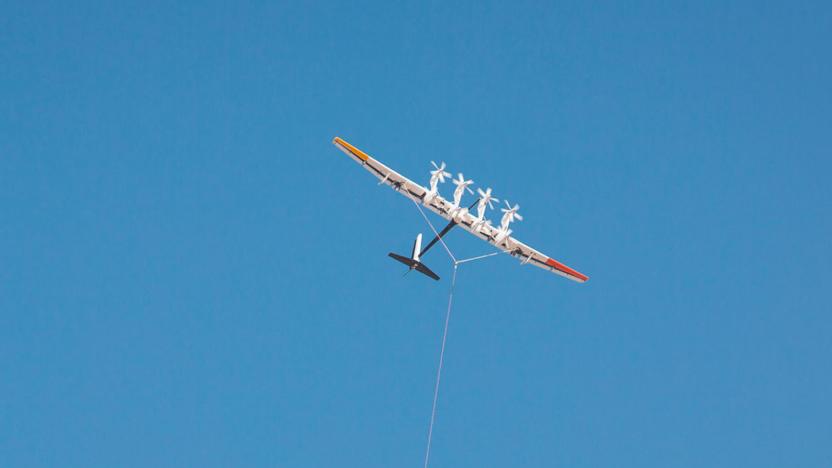
Shell backs Alphabet's power-generating kites in latest renewable bet
Alphabet is turning yet another one of its X projects into a business, but this time it's enlisting the help of an unusual ally. Makani Power, a venture making electricity-generating kites (see above), has become a full-fledged subsidiary of Alphabet thanks in part to a minority investment from Shell -- yes, the fossil fuel giant. The two hope to shift the technology from the land to offshore, where winds are stronger. They're betting that the kites will be easier to deploy than conventional wind farms, since they could deploy with floating buoys instead of requiring platforms that reach down to the ocean bed.
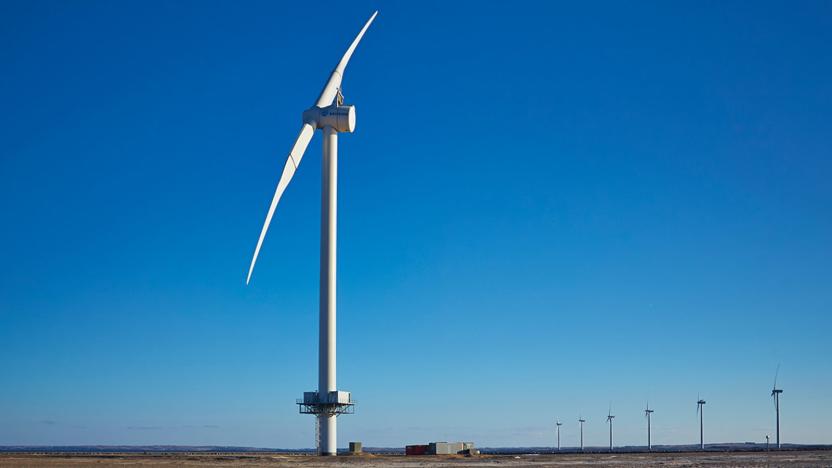
Superconducting tape could lead to lower-cost wind power
Wind power is limited in part by how expensive it can be to make each turbine. You may need roughly a ton of rare earth metals per machine... and that adds up. It could soon be much less expensive, however. The EU-backed EcoSwing project recently upgraded a wind turbine in Denmark with superconducting tape that reduces the required amount of rare earth elements to as little as 1kg (2.2lbs). That not only dramatically reduces the costs (down from $45.50/kg to $18.70/kg), it reduces weight and size requirements. You can produce the same power for about half the weight and volume of a conventional turbine, the University of Twente's Marc Dhalle told Chemistry World.
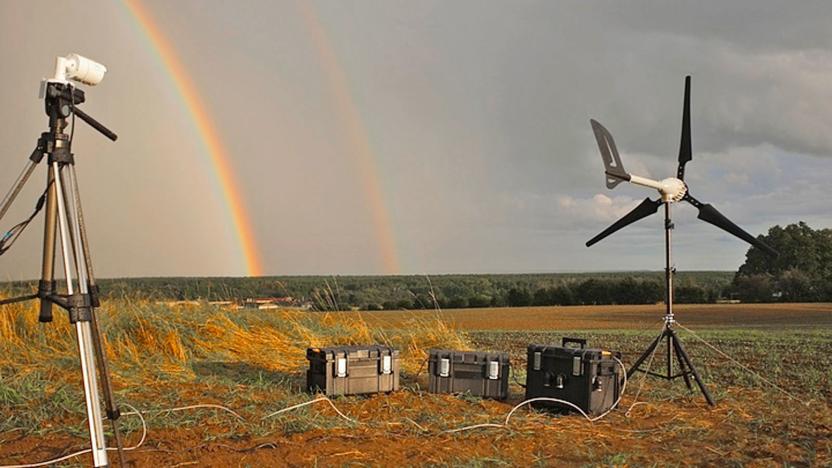
Wind energy mines digital cash to support climate research
Climate change is frequently described as a vicious cycle that depletes the very resources needed to fight it. In the case of Julian Oliver's latest project, however, it could almost be described as virtuous. His Harvest project uses a 700W wind turbine to power a PC mining cryptocurrency (specifically, Zcash) that directly funds climate change research. In other words: the more the symptoms of climate change manifest themselves, the more money goes toward fighting that change. It was commissioned as a piece of art, but it's a very practical design that could find plenty of uses in the real world.
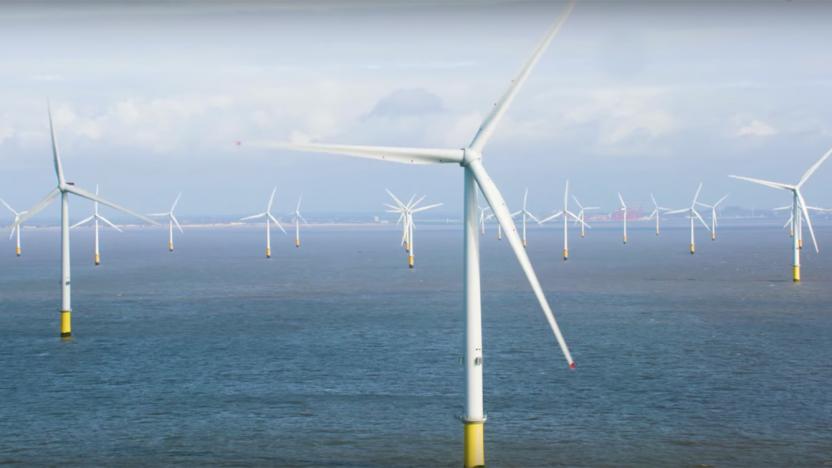
UK switches on the world's largest wind turbines
The largest wind turbines in the world have recently started producing energy for the UK. Dong Energy, the Danish company behind the project, has recently switched on the 32 gigantic structures in Liverpool Bay. The turbines are taller than some skyscrapers at 640 feet and have 262-foot-long blades that can generate 8 megawatts of power. It's the first time 8MW turbines are used for commercial purposes, and a single revolution of their blade, the company says, can power one house for 29 hours.
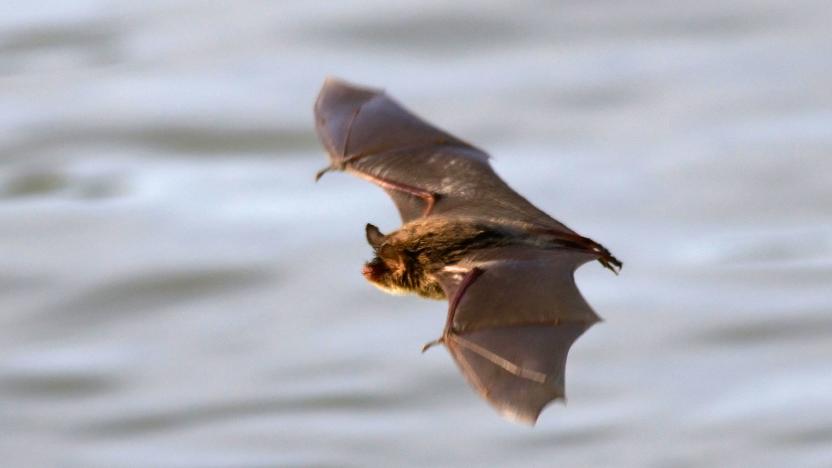
Saving bats from wind turbines is easy
Renewable energy like wind power is touted as a great way to reduce our impact on the environment. Tech companies like Google and Tesla, along with cities like San Francisco, understand the need to go green. Still, even renewable sources of energy can have hidden effects on local animal populations. The world's largest solar power plant, in fact, kills thousands of birds annually at its Ivanpah, California site. A new study in Sweden found that the country's wind turbines kill tens of thousands of bats annually -- an average of 10 to 15 bats per turbine. The answer? Halt the spinning of the fans during the summer evenings when wind is low anyway.

All electric trains in the Netherlands now run on wind energy
The Netherlands has been harnessing the power of the wind to drain bodies of water, saw timber and to produce oil for centuries. Now, the country is also using it to run all its electric trains. The Dutch railways network (NS) started using wind energy generated by the turbines owned by electric company Eneco two years ago when they signed a ten-year agreement. They planned to power all of the country's electric trains with wind-generated energy by 2018, but they're clearly a shining example of Dutch efficiency and reached their goal a year earlier than planned.

ICYMI: The ESA's mission to Mars launches next week
try{document.getElementById("aol-cms-player-1").style.display="none";}catch(e){}Today on In Case You Missed It: The European Space Agency and Russia are joining up to launch their ExoMars project next week, which will look for traces of extraterrestrial life on the red planet. Meanwhile, a newer kind of wind energy harvester is being installed in Paris, where leaves on a fake tree can capture energy in breezy conditions.
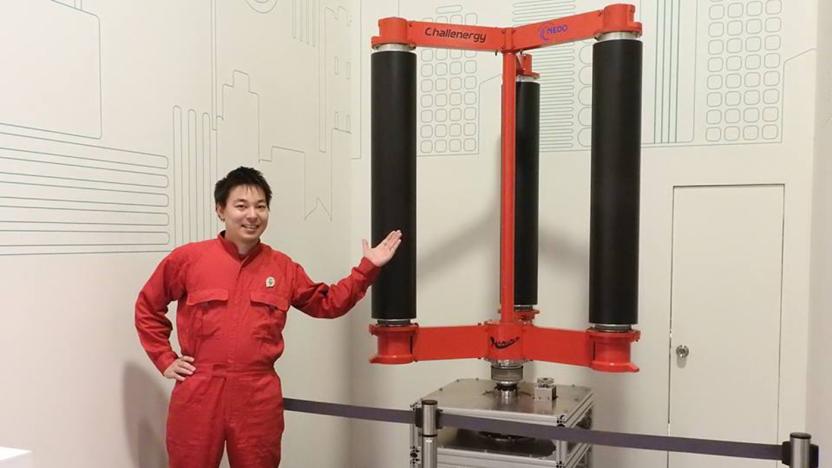
Japanese inventor's typhoon turbines harness storms' energy
A Japanese engineer named Atsushi Shimizu has designed a new type of wind turbine that can harness energy from something more powerful than a strong breeze. Shimizu's creation, which looks like a huge, upright egg beater, can withstand typhoons (or hurricanes, depending on where you live) and turn their destructive power into usable energy. Unlike ordinary turbines, it can stay standing even when assaulted by intense winds and rain, thanks to an omnidirectional vertical axis and blades with adjustable speeds. That makes them perfect for their creator's home country, as well as other places frequently visited by storms, such as China, the Philippines and the US.

Mechanical 'trees' generate energy by swaying in the wind
What if windmills looked more like trees? Well, a team of engineers at Ohio State University is looking for answer to that question with structures that resemble trees, but actually create energy when they move in the breeze. That swaying motion from the wind, and the resulting structural vibrations, is converted into electricity with electromechanical materials such as polyvinylidene fluoride (PVDF). The project isn't merely concerned with those tree-like structures, though. It also looks to harvest the energy generated from the vibrations of buildings and bridges.
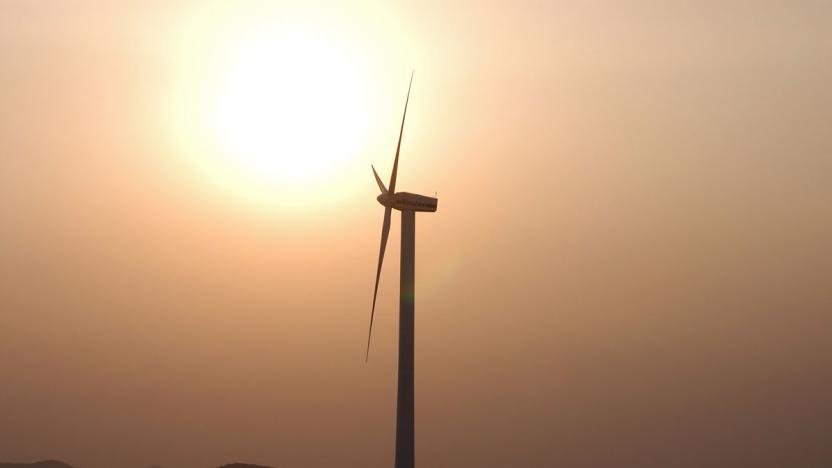
Google invests in Africa's largest wind power farm
Google's big bet on clean energy isn't just limited to the US or Europe -- far from it. The search firm just promised to invest in Africa's largest wind farm, the Lake Turkana Wind Power Project in Kenya, by buying turbine maker Vestas' 12.5 percent stake when the farm is complete. Lake Turkana should generate 310MW of energy when all is said and done, or as much as 15 percent of Kenya's current output. That could not only help the country transition to green energy sources, but give it the kind of reliable electricity that's tough to find in the region.

UK government pulls support for new onshore wind farms
In the future, there's a good chance you'll see fewer wind farms being erected in the British countryside. That's because the UK government is killing a subsidy scheme that gives onshore wind farms a helping hand when they sell their electricity to energy suppliers. Under the Renewables Obligation (RO) order, Ofgem currently awards wind farms special certificates based on the amount of electricity they generate. They then sell these to the UK's energy providers, earning a premium on top of their normal wholesale prices.
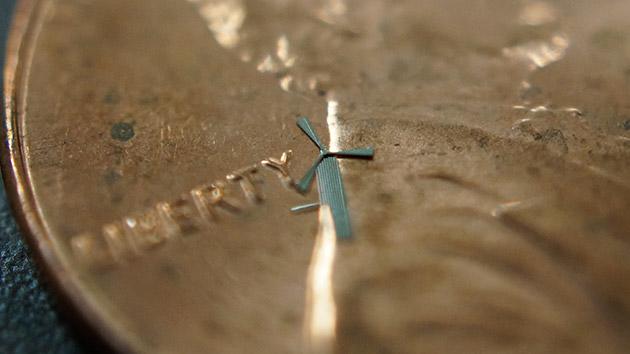
Researchers develop tiny windmills that can power your gadgets (video)
Portable solar chargers aren't so out of the ordinary anymore, but minuscule windmills that can charge your phones? Now, those are something new. A couple of UT Arlington researchers, Smitha Rao and J.C. Chiao, have developed wind turbines so small (they measure 1.8mm at their widest), you can stick 10 of them on a grain of rice. One possible application is to embed a bunch of the Lilliputian devices onto a phone sleeve -- you can then simply hold your phone out the window or place it in front of a fan to recharge. Since the tiny windmills are made of durable nickel alloy, you won't have to worry about strong wings blowing their little blades off, either. Although it's still too early to say if this leads to an actual product, a Taiwanese company is already exploring commercial opportunities, so cross your fingers if you dream of owning a wind farm for ants.

Google buys Swedish wind farm's entire output to power Finnish data center
Google has just secured the services of an entire 72MW wind farm in Maevaara, Sweden for the next ten years to keep its Finnish data center humming, according to the official blog. It brokered the deal through German insurer Allianz, which purchased the farm and will begin selling all the electricity it produces to Mountain View by 2015. The move is part of Google's quest to remain carbon neutral, and is along similar lines to a recent deal which saw the search giant purchase 48MW of energy from a wind farm in Oklahoma. The news follows Apple's announcement that it gets 75 percent of its power from renewable sources -- showing the arch-foes can at least agree on something.

Google data center in Oklahoma to get 48MW of wind power, boost renewable energy in the Sooner state
Google has made a point of relying on renewable resources for its data centers whenever possible, even down to the cooling. It hasn't had quite as unique an arrangement as what it's planning for its data center in Oklahoma, though. The search firm wants to supply its Mayes County location with 48MW of wind energy from Apex's Canadian Hills Wind Project, but it isn't buying power directly from the source. Instead, it's making a deal with the Grand River Dam Authority, a utility, to purchase the clean power on top of what's already supplied from the GRDA at present. The deal should keep the data center on the environmentally friendly side while giving it room to grow. Wind power will come online at Google's facility once the Canadian Hills effort is up and running later in 2012; hopefully, that gives us enough time to better understand why there's a Canadian River and Canadian Hills to be found in the southern United States.

NTT DoCoMo to power cellphone towers with renewable energy, tenderness
When they're not busy carving handsets out of teak (or rockin' out with their pupils), the folks over at NTT DoCoMo apparently focus their efforts on saving the environment. Next year, the Japanese provider will begin outfitting its expansive cellphone tower network with ten "green transmission stations," to be powered by an artillery of biofuels, wind and solar energy. This kind of infrastructure would obviously bring a smile to the face of ol' Mama Nature, but it could also help mitigate the adverse effects of power outages and elfin insurgents. And for that, we should all be grateful.

Google backs Alta Wind Energy Center, boasts $400 million clean energy milestone
Google announced today that it's throwing $55 million dollars to the wind... energy, that is. A post to the official Google blog said the company has invested the aforementioned amount in the Alta Wind Energy Center, which is set to generate 1,550 megawatts of energy -- enough to reportedly power 450,000 homes -- from a batch of turbines in the Mojave Dessert. Developed by Terra-Gen Power, the operation will carry the resulting energy via transmission lines to "major population centers." The ever-humble internet giant pointed out that this particular injection of funds marks a total investment of $400 million in the clean energy sector. In fact, El Goog signed a deal last year to power several of its data centers with wind power, and most recently announced the opening of a seawater-cooled data center in Finland.

Green Energy will replace fossil fuels by 2050 if you really really want to
The year 2050 is what the year 2000 was to futuristic thinkers like Walt Disney and Arthur C. Clarke. It's the new year that everything will change: robots will outperform us on the field of play, computers will outwit us in matters of reason, and nerds will never be lonely again. It's also the year that 100 percent green energy will be possible according to a bunch of neo-maxi zoomdweebies from Stanford and the University of California-Davis. That's right, in 40 years we could be saying goodbye to fossil fuels in favor of renewables like solar and wind power. The biggest challenge to achieving the goal, say researchers, isn't related to the underlying technologies or the economics required to fuel the change, rather, it's whether we earthlings have the collective will and political gumption to make it happen. Interesting... we'll look into that claim just as soon as we're done with our Nero fiddling and telling all our friends about this amaaazing story we just read in the National Enquirer.

Philadelphia Eagles going self-sufficient on stadium energy from 2011, 30 percent of it renewable
Let's skip right past the cringe-worthy "Declaration of Energy Independence" slogan and look at what the Eagles are actually doing with their pro sports venue. The franchise that dresses in midnight green is aiming to smarten up its eco-green credentials with a new partnership with SolarBlue that will provide all of the Eagles' stadium energy needs for the next 20 years, after which point the team will be free to resell any surplus electricity back to the grid. 15 percent of the total output with be generated with spiral wind turbines erected around the top rim of Lincoln Financial Field, another 15 will come from 2,500 solar panels to be installed near the stadium, and the rest will be obtained from a biodiesel / natural gas plant. So it's not all renewable, but a nice step in the right direction, nonetheless.

Google sinks cash into Atlantic Wind Connection offshore wind project
It's been said before, but seriously -- is there anything that Google won't invest in? The company that's also looking into ISPs, voice search and Pac-Manning its home page is now sinking a few billion (give or take) into an ambitious new offshore wind project. The move comes just months after inking a score-long deal to power data centers with wind energy, and Google's involvement is helping the Atlantic Wind Connection backbone move forward. In theory, this backbone will stretch 350 miles off the coast from New Jersey to Virginia and will be able to connect 6,000MW of offshore wind turbines, and the AP reports that the initial phase of the project will be capable of "delivering 2,000 megawatts of wind energy, or enough to power about 500,000 homes." Good Energies, Marubeni and Trans-Elect are also getting in on the action, with the aforesaid first phase to be completed by early 2016. Also, it's expected that the energy created from this endeavor will cost "several times more than conventional electricity," but obviously the Big G views this as a solid long-term investment.

World's largest offshore wind farm spins into action off the coast of Britain
They stretch up to two and a half times the height of Nelson's Column at Trafalgar Square, their number is close to a hundred, and their mission is to bring clean, renewable energy into British homes. Yes, we're talking about turbines. The latest wind farm to be erected near the Queen's most sovereign isles is said to be the largest in the world (for now) and promises to produce enough energy to keep 240,000 homes going -- the equivalent of half the county of Kent. It's part of the UK's grand plan to generate at least 20 percent of all its power needs through the taming of the winds and cost the Kingdom a cool £780 million ($1.2b) to build. That's admittedly a big bill to swallow, but there are worse things to blow your billions on... such as, say, the Millennium Dome.









